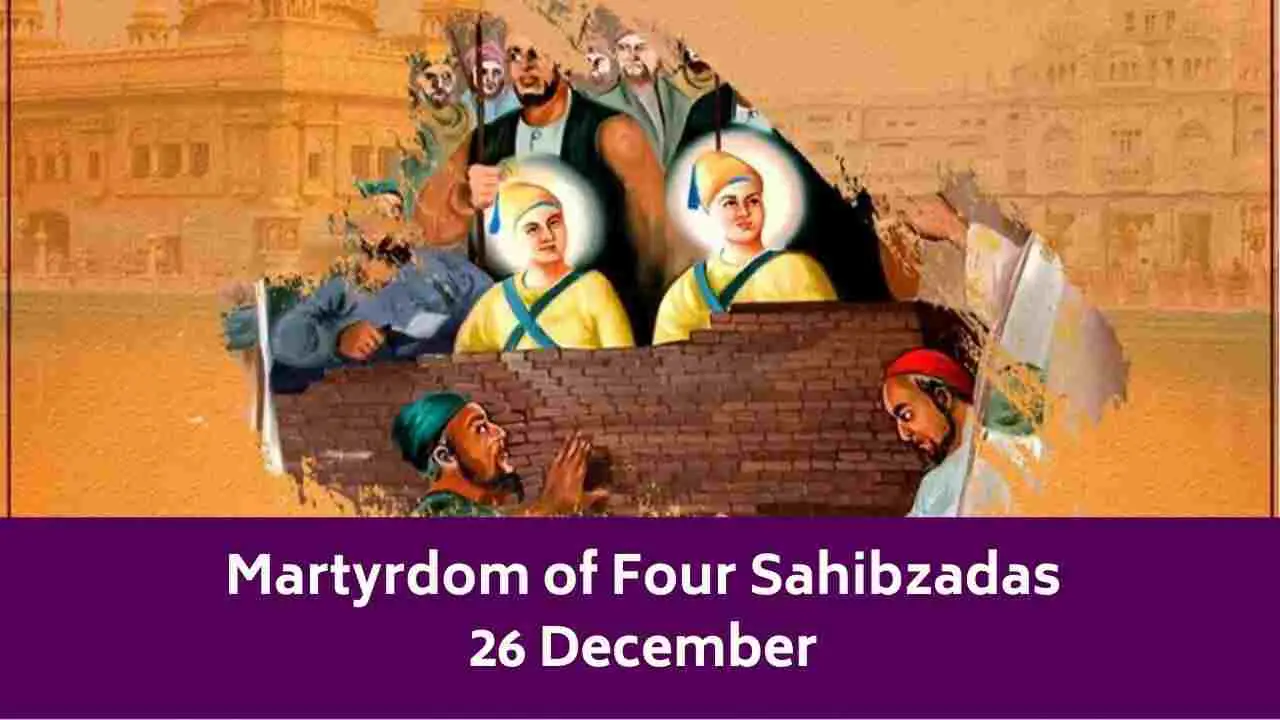Martyrdom of Four Sahibzadas – 26 December
“Waheguru ji ka Khalsa, Waheguru ji ki Fateh”
The history of the Sikhs and of Punjab is incomplete without an honourable and sombre mention of the martyrdom of the four ‘Sahibzadas’, the younger sons of Guru Gobind Singh, the tenth Sikh Guru.
The Sikh Legacy: A Journey of Faith and Courage
The word ‘Sikh’ in Punjabi originates from the Sanskrit word ‘Shishya’, which translates to ‘learner’ or ‘disciple’. The Sikhs, as a community, embody the spirit of discipleship and follow the path laid down by the revered gurus, from Guru Nanak Dev ji to Guru Gobind Singh ji. These gurus played a pivotal role in uniting and empowering the people of northern India in particular.
Guru Nanak Dev Ji: The Foundation of Sikhism
While a martial tradition took root within the Sikh philosophy at a slightly later stage, even Guru Nanak Dev ji, the founder of Sikhism, was a revolutionary figure in both religious and social spheres. He rejected the divisions and inequalities perpetuated by the caste system and orthodox social conventions, proclaiming the equality of all individuals. His teachings laid the foundation for a more inclusive and egalitarian society.
Guru Gobind Singh: The Saint-Soldier
Moving forward, Guru Gobind Singh, the tenth Guru of the Sikhs, often referred to as the Saint-Soldier, was a culmination of the spiritual light that began with Guru Nanak, and the martial tradition that some of his predecessors had encouraged and honed.
The Khalsa and the Struggle Against Tyranny
In his youth, he immersed himself in self-education and was deeply influenced by the belief that God sent saviours to uphold righteousness and combat evil. He felt a personal calling. And with the establishment of the Khalsa – literally, the ‘pure’, an embodiment and codification the Sikh identity – Guru Gobind Singh aimed to create a community of the fearless and selfless.
The Betrayal and The Battle of Chamkaur
However, the rulers of the time perceived him as a threat to their authority. After his twelfth battle against some of the tyrannic rulers of the times, he was compelled to leave his home base in Anandpur. This was upon receiving a promising message from the rulers that if the Guru evacuated Anandpur, the fighting would cease, and he and his Sikhs would be unharmed. But it was a play of deceit. The Guru and his contingent had barely ventured forth when they were waylaid by those who had assured them of a secure departure.
A Night of Peril and Loss
In a valiant stand, Ajit Singh, the eldest son of the Guru, led the rear-guard against the relentless pursuers. Udai Singh, a warrior of exceptional valour renowned in numerous battles, also took command, holding the enemy at bay, finally succumbing to the uneven struggle. Meanwhile, the Guru reached the swollen Sirsa stream amid a chilling winter, attempting a perilous crossing.
The Flight and Sacrifice
Pressed by the relentless pursuit, the contingent scattered in the harrowing cold night. Some Sikhs lost their lives in the icy waters, while the survivors dispersed. The Guru’s mother, Mata Gujri, along with his younger sons Zorawar Singh and Fateh Singh, fortuitously met Gangu, an old household servant, who pledged to guide them safely to his village. Simultaneously, a loyal Sikh from Delhi offered to lead the Guru’s wife to safety. The Guru’s party dwindled to forty Sikhs and his two elder sons, Ajit Singh and Jujhar Singh.
The Siege of Chamkaur
Hotly pursued by troops bolstered by reinforcements from Delhi, as well as local chieftains eager for any chance to attack, the Guru sought refuge in a mud-walled house in the village of Chamkaur. He orchestrated the defence, dividing his small force to cover each side of the improvised fortress. Alam Singh and Man Singh took sentinel roles, while the Guru, his sons, and warriors Daya Singh and Sant Singh, positioned themselves on the top floor.
CBSE Circular on ‘Veer Baal Diwas’ 2023; Guideline, Rules and Activities
The Battle Against Overwhelming Odds
As the advancing massive army encircled the village tightly, an epic struggle commenced, pitting the forty against a multitudinous horde. The imperial army attempted to scale the house’s walls but faced resolute resistance. By nightfall, only five Sikhs remained, the lone survivors of the valiant warriors.
The Guru’s Departure from Chamkaur
Faced with a seemingly hopeless situation, the survivors made a resolution, urging the Guru to leave Chamkaur for the sake of the Khalsa’s future. Reluctantly, the Guru yielded. Sant Singh and Sangat Singh chose to stay in the fortress, while Daya Singh, Dharam Singh, and Man Singh accompanied the Guru.
Evading the besieging troops, the Guru emerged from the fortress, extinguishing the night torches with a shower of arrows, creating chaos and allowing his escape. The battle resumed in the morning, and the two Sikhs holding the fortress rained arrows on the encircling army. However, the Mughal soldiers scaled the walls, decapitating Sant Singh and his companion, only to discover the absence of Guru Gobind Singh.
Reflections of a Warrior: The Letter to Aurangzeb
The Battle of Chamkaur, occurring on December 7, 1705 prompted Guru Gobind Singh to reflect in a subsequent letter to Aurangzeb in Persian. He expressed the futile struggle of forty famished men against a large force. Despite engaging in combat, the Sikhs valiantly went forth in batches of five, accepting certain death. The poignant moments arose when the Guru’s sons, Ajit Singh and Jujhar Singh, begged to court death, which the Guru granted.
Take the Veer Baal Diwas Quiz & Earn Government Certificate
The Final Stand of the Sahibzadas
In the group led by Ajit Singh, Alam Singh stood out, along with other martyrs like Mohkam Singh, Sahib Singh, and Himmat Singh. The Guru’s sons displayed extraordinary courage, causing significant destruction before succumbing. Ajit Singh impaled many enemies with his spear, while Jujhar Singh tore through the Mughal army like a crocodile in a stream.
The Siege and the Fall
The Subedar of Lahore, frustrated by the havoc wrought by the small Sikh groups, attempted to storm the fortress but retreated under a barrage of arrows. The Sikhs, despite their whizzing arrows and tumultuous battle, faced insurmountable odds.
The Ultimate Sacrifice: The Martyrdom of Sahibzadas
The Battle of Chamkaur claimed the lives of two of Guru Gobind Singh’s four sons in a single day. Near Sirhind, within a week, the Guru’s remaining sons, not yet in their teens, faced the executioner’s sword with equal courage, also facing deceit. Gangu, entrusted with the Guru’s younger sons and their grandmother after the calamitous Sirsa crossing, betrayed their trust.
Accompanying him to his village, Saheri, the unsuspecting wards followed, finding hospitality in his home. However, Gangu, driven by deceit, stole from Mata Gujari’s belongings and feigned ignorance, casting blame on others, when confronted.
Betrayal and Imprisonment
Protesting vehemently, Gangu informed the village headman of Guru Gobind Singh’s family in his house. Together, they sought a handsome reward from the chief of Morinda for divulging such valuable information. The chief, eager to have important hostages, took the Guru’s children and mother into custody, eventually handing them over to Nawab Wazir Khan of Sirhind.
The Trial and Courage of the Young Sahibzadas
The prisoners of Sirhind, who had led expeditions against the Guru, were confined in a tower of the fort. On December 9, 1705 the Guru’s sons were summoned to appear before Wazir Khan.
The grandmother found it painful to part with her grandsons, but Zorawar Singh urged them to face the inevitable. In court, the young boys boldly greeted with ‘Wahguru ji ka Khalsa, Wahguru ji ki Fateh’, astonishing everyone. Sucha Nand, a minister, informed them of their family’s fate and advised to convert faith for survival.
Unyielding Faith and the Ultimate Sacrifice
Zorawar Singh’s resolute response emphasized their upbringing to bow before God and the Guru alone. Rejecting conversion, they faced the wrath of Wazir Khan, who promised leniency, estates, and noble marriages if they converted their faith.
Unyielding, the brothers asserted they sought neither wealth nor position, willing to forfeit their lives but not their faith. Wazir Khan ordered them to a prison cell, later bricking them up in a wall alive. Both laid their lives but were unshakeable in their faith.
The Aftermath: A Legacy of Bravery and Faith
Todar Mal, a wealthy merchant, arrived too late to pay ransom for the release of Guru Gobind Singh’s children. He broke the tragic news to Mata Gujari, who, consumed with anxiety during those tormenting days, fell into a swoon, from which she never recovered.
The martyrdom of ‘Sahibzadas’ has no parallel in human history. To pay tribute to such unprecedented martyrdom of the Sahibzadas of the tenth Guru, Guru Gobind Singh Ji, 26 December is celebrated as “Veer Bal Diwas”. The sacrifice of the Guru’s young sons remains a poignant and morally uplifting testament to their unwavering faith and courage. Post Source: CBSE
“Waheguru ji ka Khalsa, Waheguru ji ki Fateh”
CBSE Sample Papers | CBSE Circulars | Quizzes | Study Material
Click Here to Join our Premium Telegram for More News and Updates.
Download ShikshaPress App For Free Educational Updates
For the Latest Educational News (CBSE, ICSE, and State Board News) and live news updates, like us on Facebook or follow us on Twitter and Join our Premium Telegram Channel. Read more on Latest Exams & Results News on Shikshapress.com.






